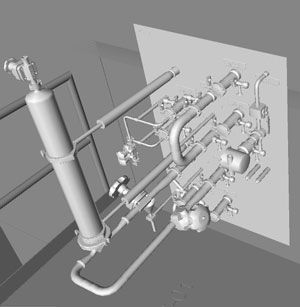Using Digital Tools to Optimize Facility Design
Digital tools, such as building information modeling (BIM) software, improves efficiency for optimizing pharmaceutical facility design.
CHAAY_TEE - STOCK.ADOBE.COM

Technology is changing more than just healthcare’s latest therapeutic modalities and pharmaceutical advances. It’s also disrupting the design and implementation of the facilities that create them. Building information modeling (BIM) is at the helm of this digital disruption. BIM is a 3D, digital facility model that can be optimized to include schematic drawings, product information, engineered data calculations, estimation, and automated instrumentation. When retrofitting, scanning equipment can capture an existing facility’s space and provide a cloud of data that is easily converted to a full, 3D BIM model.
Whether new construction or retrofit, BIM streamlines workflow coordination, allows late submittals to be facilitated more quickly and easily, permits building owners and operators to offer real-time feedback during early design, and can automate and optimize equipment specification.
Improved process efficiencies
From the design team to equipment vendors and subcontractors, when the entire building team works from a single, digital model, efficiencies are championed. Unfortunately, late submittals are a rule rather than an exception in today’s building design process. As project schedules become more fast paced, equipment specification and delivery moves more in parallel to construction, and sometimes even beyond. Final coordination isn’t possible until all submittals are in. BIM can be used for clash detection, and it facilitates late design submittals, avoiding common, costly change orders.
Figure 1. A model of a transfer panel allows digital testing of potential layouts. Image is courtesy of the author.

As a case in point, during the construction of a large biologics manufacturing facility, a last-minute design submittal came through. The transfer panels (i.e., wall-mount piping assemblies) in fabrication took up more space in the facility than initially anticipated. The design team had to determine the best solution, weighing long-term operating effects against the short-term cost/schedule changes to modify plans. BIM allowed the design team to digitally test all the potential building layout scenarios this change posed without making any costly mistakes in the field (see Figure 1). Without BIM, this change would have easily cost the project an additional two to four months of construction time.
A new project view
With a 3D BIM model of the facility, clad with equipment specifications; mechanical, electrical, and plumbing infrastructure; and architectural design, building owners, operators, and other end-users have a unique opportunity to “walk through” a building, room by room, using virtual reality software and googles. This technology provides an avenue for real-time feedback during the early project design phase.
Engaging end users is often complicated by their day jobs. But when they have a chance to review a 3D image of the facility prior to sub-contractor fabrication models, their participation soars and the feedback is received in enough time to actually influence facility design rather than modifying it. Pulling the design-review phase forward saves time and reduces the project’s overall bottom line. While redesign can’t be avoided, it can be moved forward to ensure that everyone-including lab managers/operators, maintenance personnel, and even C-suite executives who take an interest in daily operations-is on the same page faster.
As an example, during the design phase of a manufacturing facility, end users that reviewed the 3D model had a number of very practical change requests. One group of end-users wearing virtual reality glasses noted that they wouldn’t be able to reach a valve. Another group pointed to an area above a lab station and suggested a window be placed there. In both scenarios, designers were able to go into the BIM model and annotate it in real time. Later, designers went back to the comments tagged to alter the design.
The facility owners continue to use the 3D images created via BIM during design to give visitors a virtual tour of their facility. This technique allows them to give access to the facility without a vistor having to gown up to enter clean or secure spaces. BIM models can also be used to train operations staff or aid maintenance.
Streamlined equipment coordination
Three-dimensional, digital design allows facility designers to solve their project challenges in creative ways. Designers can work with existing tools or create new ones. One one complex project, for example, the design team was tasked with tackling a large amount of equipment design-10,000 instruments all together-in a short amount of time. Because there wasn’t another efficient way to do so, the CRB team designed an automated instrumentation design and specification tool to coordinate with the BIM model. What would have taken weeks instead took hours to specify with the new tool. Using the tool, designers were able to create a template specification for each type of instrument, review it with the owner for approval, and then populate each unique instance for that instrument within BIM. When expanded beyond instrumentation, the tool can also manage the information associated with equipment, such as physical location, and it can facilitate the generation of datasheets, lists, etc. All process data are linked with the schematic design. The instrumentation tool streamlined the design, layout, and construction of the facility, helping owners with facility management, maintenance routines, and more.
Next-generation biotech facilities
Shorter project timelines, increased demand for sustainability, and the availability of big data are driving forces in facility design. BIM pushes the envelope of design, resulting in better processes, optimized workflow, reduced cost, and ultimately, the next generation of biotech facilities.
About the author
Clay Seese is Biotech business unit leader at CRB, Clay.Seese@crbusa.com.
Article Details
Pharmaceutical Technology
Vol. 43, No. 9
Pages: 54–55
Citation
When referring to this article, please cite it as C. Seese, "Using Digital Tools to Optimize Facility Design," Pharmaceutical Technology 43 (9) 2019.

Pharmaceutical Tariffs Are Imminent: How Industry is Bracing for Impact
April 16th 2025On April 14, 2025, the Trump Administration launched a national security-driven investigation into pharmaceuticals, a move that will likely result in tariffs being placed on pharmaceutical drugs, ingredients, and other components that are imported from outside of the United States.
Drug Solutions Podcast: A Closer Look at mRNA in Oncology and Vaccines
April 30th 2024In this episode fo the Drug Solutions Podcast, etherna’s vice-president of Technology and Innovation, Stefaan De Koker, discusses the merits and challenges of using mRNA as the foundation for therapeutics in oncology as well as for vaccines.